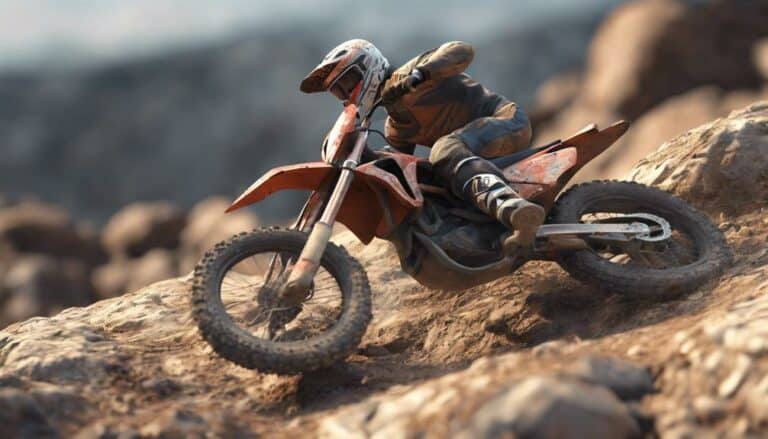If you're considering taking your street legal dirt bike off the beaten path, you might want to pause and ponder the potential drawbacks. While these bikes are versatile, their dual nature might pose some challenges once you hit the trails.
From safety concerns to regulatory roadblocks, the terrain ahead could be bumpier than you anticipate.
Key Takeaways
- Street legal dirt bikes may lack essential off-road safety features and appropriate tires for rough terrains.
- Design limitations like limited suspension travel and ground clearance affect off-road performance.
- Regulatory challenges and road-oriented design can hinder maneuverability on off-road trails.
- Environmental impact concerns include emissions, noise pollution, and air quality issues in off-road settings.
Noise and Emission Concerns
When riding street legal dirt bikes off-road, you may encounter significant noise and emission concerns that can impact the environment and limit access to certain riding areas. Street legal dirt bikes, with their louder exhaust systems, can contribute to noise pollution in off-road settings, disturbing wildlife and affecting the tranquility of environmentally sensitive areas. Additionally, emission regulations designed for street use may not be suitable for off-road environments where air quality and environmental impact are significant concerns.
The emissions from street legal dirt bikes could potentially harm the air quality in off-road locations, further exacerbating the environmental impact. Also, the noise levels generated by these bikes may lead to complaints from local residents or conservation groups, prompting access restrictions to certain riding areas. These limitations highlight the importance of considering the impact of noise pollution and emissions when choosing to ride street legal dirt bikes off-road.
It's important to be mindful of the environmental consequences to make sure the preservation of natural habitats and maintain access to off-road riding areas.
Safety Feature Limitations
Street legal dirt bikes may lack essential off-road safety features, increasing the risk of damage and injury during off-road riding adventures. These bikes often come without skid plates and hand guards, leaving crucial components vulnerable to impact and debris. Additionally, their street-oriented tires may not offer sufficient traction on loose or muddy terrains, compromising stability and control.
The lighting systems on street legal dirt bikes may not be robust or bright enough for exploring dark off-road trails effectively, potentially leading to visibility issues and safety concerns. Furthermore, the limited ground clearance of these bikes compared to off-road specific models can result in underbody damage and challenges when traversing rough terrain.
The weight distribution and design of street legal dirt bikes may not be optimized for off-road riding, impacting maneuverability and overall handling on trails. Considering these limitations, riders should exercise caution and consider upgrading safety features before setting off on demanding off-road journeys.
Road Regulations Incompatibility
Considering the limitations of using street legal dirt bikes for off-road riding, the incompatibility with road regulations can greatly impact the bike's performance on challenging terrains.
- Design Limitations: Street legal dirt bikes are designed to comply with road regulations, leading to compromises in off-road performance due to the lack of essential off-road features like long suspension travel and knobby tires.
- Performance Limitations: Modifications made for street legality, such as lights and mirrors, may not be suitable for off-road riding, affecting the bike's maneuverability and overall performance on rough terrains.
- Handling Capabilities: Incompatibility with off-road trails and obstacles due to the focus on street regulations can limit the bike's handling capabilities, making it less suitable for demanding off-road environments.
- Riding Environments: Striking a balance between road regulations and off-road terrain requirements can be challenging, resulting in limitations in the bike's versatility across different riding environments.
These factors highlight how the intersection of road regulations and off-road riding demands can create hurdles for street legal dirt bikes in delivering optimal performance off-road.
Performance and Handling Challenges
Performance and handling challenges arise when utilizing street legal dirt bikes for off-road riding due to their design limitations optimized for on-road conditions. The off-road obstacles can expose weaknesses in the bike's performance, primarily in handling and suspension.
Street legal dirt bikes may struggle with challenging off-road terrains due to their limited suspension travel and tire choices, affecting their ability to navigate rough terrain effectively. Additionally, the weight distribution and geometry optimized for on-road use can hinder the bike's maneuverability in off-road conditions, making it harder to handle in demanding situations.
The lack of ground clearance and durability on street legal dirt bikes can further exacerbate these challenges, as they may not withstand the rigors of intense off-road riding. Overcoming these obstacles requires riders to adapt their riding style and approach to compensate for the bike's design limitations, ensuring a smoother off-road experience.
Insurance and Liability Considerations
When engaging in off-road riding activities with street legal dirt bikes, understanding the importance of insurance coverage and liability considerations is paramount for safeguarding against potential financial risks and legal consequences. Here are some key points to take into account:
- Lack of insurance coverage for off-road accidents may result in personal liability for damages and injuries.
- Compliance with insurance requirements is essential to mitigate risks associated with off-road riding.
- Understanding liability issues and insurance challenges is critical for a legal off-road riding experience.
- Failure to have insurance for off-road activities may lead to financial consequences in case of accidents.
Having proper insurance coverage for off-road adventures ensures protection against potential liabilities and damages. It's essential to be aware of the risks involved and ensure that you have the necessary insurance coverage to protect yourself in case of unforeseen accidents or damages during off-road riding. Stay compliant with insurance regulations to enjoy a safe and worry-free off-road experience.
Conclusion
So, next time you decide to take your street legal dirt bike off-road, remember the irony of its limitations. From lacking safety features to struggling with road regulations, these bikes may not be the best choice for off-road adventures.
But hey, who doesn't love a challenge? Just make sure you're prepared for the ride of your life, both literally and figuratively.

